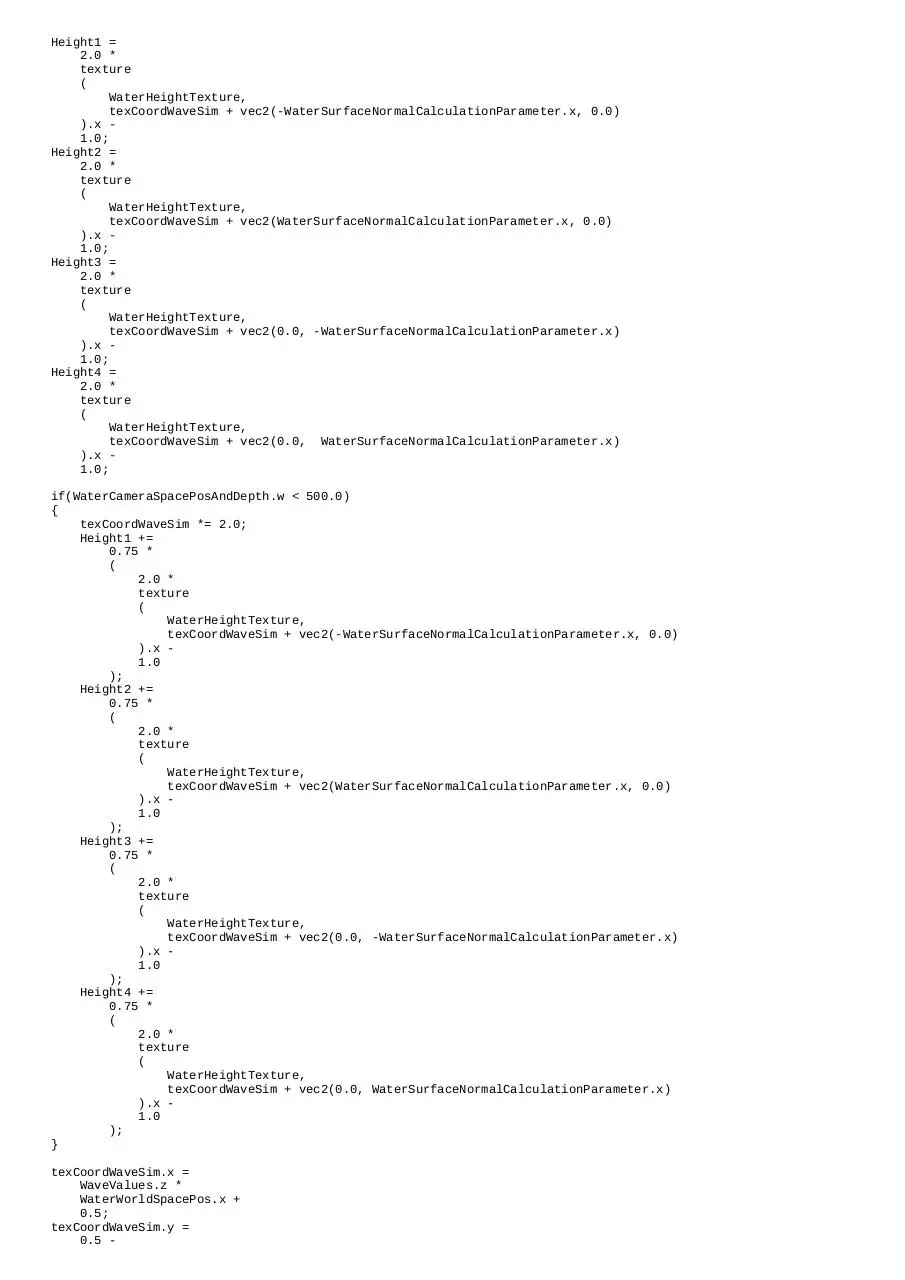Listing 1 (PDF)
File information
Title: Listing 1
Author: ich
This PDF 1.4 document has been generated by PDFCreator Version 1.7.2 / GPL Ghostscript 9.10, and has been sent on pdf-archive.com on 18/04/2014 at 13:24, from IP address 91.113.x.x.
The current document download page has been viewed 893 times.
File size: 53.94 KB (14 pages).
Privacy: public file





File preview
Listing 1: Darstellung des Wasserbassins (Vertex Shader)
#version 330
precision highp float;
#define ATTR_POSITION 0
[...]
#define ATTR_TEXCOORD7 9
layout(location = ATTR_POSITION) in vec4 gs_Vertex;
[...]
layout(location = ATTR_TEXCOORD7) in vec4 gs_MultiTexCoord7;
out vec4 gs_TexCoord[8];
uniform mat4 matWorldViewProjection;
void main()
{
gl_Position
= matWorldViewProjection * gs_Vertex;
gs_TexCoord[0] = vec4(gs_Vertex.xyz, gl_Position.z);
}
Listing 2: Darstellung des Wasserbassins (Fragment Shader)
#version 330
precision highp float;
in vec4 gs_TexCoord[8];
out vec4 gs_FragColor[5];
void main()
{
gs_FragColor[0] = vec4(0.0, 0.0, 0.0, 1.0);
// SceneCameraSpacePosAndDepth:
gs_FragColor[1] = gs_TexCoord[0];
gs_FragColor[2] = vec4(0.0, 0.0, 0.0, 1.0);
gs_FragColor[3] = vec4(0.0, 0.0, 0.0, 1.0);
gs_FragColor[4] = vec4(0.0, 0.0, 0.0, 1.0);
}
Ende
Listing 3: Eigenschaften einer Wasserfläche zwischenspeichern (Vertex Shader)
#version 330
precision highp float;
#define ATTR_POSITION 0
[...]
#define ATTR_TEXCOORD7 9
layout(location = ATTR_POSITION) in vec4 gs_Vertex;
[...]
layout(location = ATTR_TEXCOORD7) in vec4 gs_MultiTexCoord7;
out vec4 gs_TexCoord[8];
uniform mat4 matWorldViewProjection;
uniform mat4 matCamera;
void main()
{
gl_Position = matWorldViewProjection * gs_Vertex;
vec4 Position = matCamera * gs_Vertex;
gs_TexCoord[0] = vec4(Position.xyz, gl_Position.z);
}
Listing 4: Eigenschaften einer Wasserfläche zwischenspeichern (Fragment Shader)
#version 330
precision highp float;
in vec4 gs_TexCoord[8];
out vec4 gs_FragColor;
void main()
{
// SceneCameraSpacePosAndDepth:
gs_FragColor = gs_TexCoord[0];
}
Listing 5: Deferred Water Rendering – Aufbau des Fragment Shaders
void main()
{
vec4 SceneCameraSpacePosAndDepth =
max
(
texture(SceneCameraSpacePosAndDepthTexture, gs_TexCoord[0].st),
texture
(
SceneCameraSpacePosAndDepthTexture,
gs_TexCoord[0].st +
vec2(0.001, 0.001)
)
);
vec4 WaterCameraSpacePosAndDepth = texture(WaterCameraSpacePosAndDepthTexture, gs_TexCoord[0].st);
// Sicherstellen, dass Hintergrundbilder (Sky-Sphären, Billboards, etc.)
// wie weit entfernte Hintergrundobjekte behandelt werden können!
if(SceneCameraSpacePosAndDepth.w < 0.0)
SceneCameraSpacePosAndDepth.w = 10000000000000.0;
vec3 WaterCameraSpacePos = WaterCameraSpacePosAndDepth.xyz;
vec3 NormalizedWaterCameraSpacePos = normalize(WaterCameraSpacePos);
vec3 SceneWorldSpacePos = SceneCameraSpacePosAndDepth.xyz + CameraPosition;
vec2 texCoord;
[Berechnung des 3D-Welleneffekts, Listing 6]
// Kamera sowie Szenenpixel über dem Wasser (Fall 1):
if(CameraPosition.y > correctedWaterSurfaceHeight && WaterDepth < 0.0)
{
gs_FragColor = texture(ScreenTexture, gs_TexCoord[0].st);
}
else
{
[Berechnung der Wellen-Normalenvektoren, Listing 7]
// Kamera im Wasser:
if(CameraPosition.y < correctedWaterSurfaceHeight)
{
// Szenenpixel befindet sich im Wasser (Fall 2):
if(WaterDepth > 0.0)
{
[Lichtabsorption des Wassers simulieren, Listing 10]
[Unterwasser-Kaustiken berechnen, Listing 14]
vec4 ScreenColor = texture(ScreenTexture, gs_TexCoord[0].st);
CausticsIntensity *= (max(ScreenColor.x, max(ScreenColor.y, ScreenColor.z)));
// Wasserfarbe ohne Wellenbewegung!!
float diffuseIntensityWater = 0.35;
// Neuberechnung der Pixelfarbe:
gs_FragColor =
vec4(DepthColorValues * depthDependedLightIntensity, 1.0) *
(
CausticsColor *
CausticsIntensity +
ScreenColor
) +
WaterColor *
vec4(diffuseIntensityWater * InvDepthColorValues, 1.0);
}
// Kamera im Wasser, Szenenpixel über dem Wasser (Fall 3):
else
{
WaterDepth = WaterSurfaceHeight-CameraPosition.y;
float diffuseIntensityWater = 0.35;
[Lichtabsorption des Wassers simulieren, Listing 11]
[Refraktions/Verzerrungs-Effekt simulieren, Listing 15]
[spiegelnde Reflexionen auf der Wasseroberfläche, Listing 9]
[Neuberechnung der Pixelfarbe (Kamera im Wasser, Szenenpixel oberhalb) Listing 17]
}
}
// Kamera über dem Wasser, Wassertiefe größer null:
else if(WaterDepth > 0.0)
{
[Berechnung der lokalen Wasserspiegelungen (Screen Space Reflections), Listing 8]
[spiegelnde Reflexionen auf der Wasseroberfläche, Listing 9]
[Schaumkronen u. Brandung, Listing 13]
float InsideWaterViewDistance = SceneCameraSpacePosAndDepth.w – WaterCameraSpacePosAndDepth.w;
float depthValueBlue =
min
(
1.0,
max
(
0.0,
(
InsideWaterMaxViewDistance –
InsideWaterViewDistance
) *
InsideWaterInvMaxViewDistance
)
);
// Szenenpixel im Wasser in der Nähe der Kamera (Fall 4):
if(depthValueBlue > 0.0 && SceneCameraSpacePosAndDepth.w < 2000.0)
{
[Lichtabsorption des Wassers simulieren, Listing 12]
[Refraktions/Verzerrungs-Effekt simulieren, Listing 16]
[Unterwasser-Kaustiken berechnen, Listing 14]
[Neuberechnung der Pixelfarbe (Kamera über dem Wasser, Unterwasserpixel nahe der Kamera), Listing 18]
}
// Szenenpixel im Wasser fernab der Kamera (Fall 5):
else
{
// Nebel- bzw. Dunst-Berechnungen:
float OneMinusHazeValue =
max
(
0.0,
(
2000.0 WaterCameraSpacePosAndDepth.w
) *
0.0005
);
float HazeValue = 1.0 - OneMinusHazeValue;
gs_FragColor =
HazeValue *
texture(BackgroundScreenTexture, gs_TexCoord[0].st) +
OneMinusHazeValue *
(
FoamColor +
diffuseIntensity *
(
WaterColor +
ScreenSpaceReflectionColor +
SpecularIntensity *
vec4(LightColor.xyz, 1.0) +
EnvironmentSpecularIntensity *
EnvironmentLightColor
)
);
}
}
// Szenengeometrie außerhalb des Wassers (Fall 1):
else
{
gs_FragColor = texture(ScreenTexture, gs_TexCoord[0].st);
}
}
}
Listing 6: Berechnung des 3D-Welleneffekts
float MaxCalculationStep;
if(CameraPosition.y > WaterSurfaceHeight)
{
MaxCalculationStep = 10.0 * MaxWaveAmplitude;
}
else
{
MaxCalculationStep = -10.0 * MaxWaveAmplitude;
}
float ActualCalculationStep = 0.5 * MaxCalculationStep;
vec3 TestCameraSpacePos =
WaterCameraSpacePosActualCalculationStep * NormalizedWaterCameraSpacePos;
float testHeight = 0.0;
vec3 TestWorldSpacePos;
vec2 texCoordWaveSim;
float PhaseAngle, cosPhaseAngle;
for(int i = 0; i < 10; i++)
{
TestWorldSpacePos = TestCameraSpacePos + CameraPosition;
texCoordWaveSim.x =
WaveValues.x * TestWorldSpacePos.x +
0.5;
texCoordWaveSim.y =
0.5 WaveValues.x * TestWorldSpacePos.z;
/* einfache Sinuswelle:
testHeight = NegWindVector.y*(sin(WaveFrontValues.w+
NegWindVector.x*TestWorldSpacePos.x+NegWindVector.z*TestWorldSpacePos.z) +
WaveFrontValues.x*(2.0*texture(WaterHeightTexture, texCoordWaveSim).x-1.0));*/
// zykloid (trochoid)
PhaseAngle =
WaveFrontValues.w
NegWindVector.x *
NegWindVector.z *
ähnliche Welle:
+
TestWorldSpacePos.x +
TestWorldSpacePos.z;
cosPhaseAngle = cos(PhaseAngle);
testHeight =
NegWindVector.y *
(
sin
(
PhaseAngle 0.5 * cosPhaseAngle
) +
WaveFrontValues.x *
(
2.0 * texture(WaterHeightTexture, texCoordWaveSim).x 1.0
)
);
// Hinweise:
// NegWindVector.y und WaveFrontValues.x entsprechen den Wellenamplituden
// WaveFrontValues.w entspricht der Simulationszeit
ActualCalculationStep *= 0.5;
if((TestCameraSpacePos.y - WaterCameraSpacePos.y) < testHeight)
{
TestCameraSpacePos =
TestCameraSpacePos –
ActualCalculationStep * NormalizedWaterCameraSpacePos;
}
else
{
TestCameraSpacePos =
TestCameraSpacePos +
ActualCalculationStep * NormalizedWaterCameraSpacePos;
}
}
WaterCameraSpacePos = TestCameraSpacePos;
vec3 WaterWorldSpacePos = WaterCameraSpacePos + CameraPosition;
float correctedWaterSurfaceHeight = WaterSurfaceHeight + testHeight;
float WaterDepth = correctedWaterSurfaceHeight - SceneWorldSpacePos.y;
Listing 7: Berechnung der Normalenvektoren einer Wasserfläche
vec3 SurfaceNormal;
float diffuseIntensity;
float Height1, Height2, Height3, Height4;
// Für ein Unterwasserpixel muss kein Wellen-Normalenvektor berechnet werden,
// sofern sich die Kamera ebenfalls Unterwasser befindet:
if(!(CameraPosition.y < correctedWaterSurfaceHeight && WaterDepth > 0.0))
{
// Zunächst einmal sorgen wir für ein wenig zusätzliche Wellenbewegung:
float AdditionalWaveHeight =
WaveFrontValues.x *
(
2.0 *
texture(WaterHeightTexture, texCoordWaveSim).x –
1.0
);
Height1 =
2.0 *
texture
(
WaterHeightTexture,
texCoordWaveSim + vec2(-WaterSurfaceNormalCalculationParameter.x, 0.0)
).x 1.0;
Height2 =
2.0 *
texture
(
WaterHeightTexture,
texCoordWaveSim + vec2(WaterSurfaceNormalCalculationParameter.x, 0.0)
).x 1.0;
Height3 =
2.0 *
texture
(
WaterHeightTexture,
texCoordWaveSim + vec2(0.0, -WaterSurfaceNormalCalculationParameter.x)
).x 1.0;
Height4 =
2.0 *
texture
(
WaterHeightTexture,
texCoordWaveSim + vec2(0.0, WaterSurfaceNormalCalculationParameter.x)
).x 1.0;
if(WaterCameraSpacePosAndDepth.w < 500.0)
{
texCoordWaveSim *= 2.0;
Height1 +=
0.75 *
(
2.0 *
texture
(
WaterHeightTexture,
texCoordWaveSim + vec2(-WaterSurfaceNormalCalculationParameter.x, 0.0)
).x 1.0
);
Height2 +=
0.75 *
(
2.0 *
texture
(
WaterHeightTexture,
texCoordWaveSim + vec2(WaterSurfaceNormalCalculationParameter.x, 0.0)
).x 1.0
);
Height3 +=
0.75 *
(
2.0 *
texture
(
WaterHeightTexture,
texCoordWaveSim + vec2(0.0, -WaterSurfaceNormalCalculationParameter.x)
).x 1.0
);
Height4 +=
0.75 *
(
2.0 *
texture
(
WaterHeightTexture,
texCoordWaveSim + vec2(0.0, WaterSurfaceNormalCalculationParameter.x)
).x 1.0
);
}
texCoordWaveSim.x =
WaveValues.z *
WaterWorldSpacePos.x +
0.5;
texCoordWaveSim.y =
0.5 -
WaveValues.z *
WaterWorldSpacePos.z;
float phaseAngle =
WaveValues.w +
texCoordWaveSim.x *
NegWindVector.x –
texCoordWaveSim.y *
NegWindVector.z;
float tempFloat = sin(phaseAngle);
Height2 *= tempFloat;
Height4 *= tempFloat;
tempFloat = cos(phaseAngle);
Height1 *= tempFloat;
Height3 *= tempFloat;
/* Mithilfe des diffuseIntensity-Parameters simulieren wir die
Helligkeitsschwankungen der Wasserfläche.
Die zugrundeliegende Idee ist denkbar einfach – Wellenberge
erscheinen heller als Wellentäler, da sie mehr Licht in Richtung
des Spielers reflektieren können:*/
float diffuseIntensity =
WaterSurfaceNormalCalculationParameter.z *
(Height1 + Height2 + Height3 + Height4);
vec2 heightSamplePos = vec2(TestWorldSpacePos.x + 2.1, TestWorldSpacePos.z);
float WaveHeight1 =
WaveFrontValues.y *
(
AdditionalWaveHeight +
WaveFrontValues.z *
sin
(
WaveFrontValues.w +
NegWindVector.x *
heightSamplePos.x +
NegWindVector.z *
heightSamplePos.y
)
);
heightSamplePos =
vec2
(
TestWorldSpacePos.x - 2.1,
TestWorldSpacePos.z
);
float WaveHeight2 =
WaveFrontValues.y *
(
AdditionalWaveHeight +
WaveFrontValues.z *
sin
(
WaveFrontValues.w +
NegWindVector.x * heightSamplePos.x +
NegWindVector.z * heightSamplePos.y
)
);
heightSamplePos =
vec2
(
TestWorldSpacePos.x,
TestWorldSpacePos.z + 2.1
);
float WaveHeight3 =
WaveFrontValues.y *
(
AdditionalWaveHeight +
WaveFrontValues.z *
sin
(
WaveFrontValues.w +
NegWindVector.x * heightSamplePos.x +
NegWindVector.z * heightSamplePos.y
)
);
heightSamplePos =
vec2
(
TestWorldSpacePos.x,
TestWorldSpacePos.z - 2.1
);
float WaveHeight4 =
WaveFrontValues.y *
(
AdditionalWaveHeight +
WaveFrontValues.z *
sin
(
WaveFrontValues.w +
NegWindVector.x * heightSamplePos.x +
NegWindVector.z * heightSamplePos.y
)
);
Height1
Height2
Height3
Height4
+=
+=
+=
+=
WaveHeight1;
WaveHeight2;
WaveHeight3;
WaveHeight4;
diffuseIntensity +=
NegWindVector.w *
(WaveHeight1 + WaveHeight2 + WaveHeight3 + WaveHeight4);
diffuseIntensity = 0.35 + diffuseIntensity;
// Berechnung des Wellen-Normalenvektors:
SurfaceNormal =
normalize
(
vec3
(
Height1 - Height2,
(
0.5 +
0.025 *
WaterCameraSpacePosAndDepth.w
) *
WaterSurfaceNormalCalculationParameter.w,
Height3-Height4
)
);
}
Listing 8: Berechnung der lokalen Wasserspiegelungen (Screen Space Reflections)
vec4 ScreenSpaceReflectionColor = vec4(0.0, 0.0, 0.0, 0.0);
if(WaterCameraSpacePosAndDepth.w < ScreenSpaceReflectionRange)
{
vec3 ReflectionSurfaceNormal =
normalize
(
vec3
(
Height1 - Height2,
(
5.0 +
0.025 *
WaterCameraSpacePosAndDepth.w
) *
WaterSurfaceNormalCalculationParameter.w,
Height3-Height4
)
);
// gespiegelten Blickrichtungsvektor berechnen:
vec3 ReflectionVector;
vec3 ReflectionDirection = reflect(NormalizedWaterCameraSpacePos, ReflectionSurfaceNormal);
float tempDot = dot(ReflectionDirection, ReflectionSurfaceNormal);
float distanceStep = 7.0 / max(0.6, tempDot * tempDot);
float actualDistanceStep = 0.5 * distanceStep;
vec4 Projection;
float InvW;
float ReflectionvectorTexY;
float ReflectionvectorTexX;
vec3 diffVector;
vec4 TestSceneCameraSpacePosAndDepth;
float DistancSq;
float distanceTestFactor = 1.0;
int i;
for(i = 0; i < 10; i++)
{
// neue Ray-Marching-Position berechnen:
ReflectionVector =
WaterCameraSpacePos +
actualDistanceStep *
ReflectionDirection;
actualDistanceStep += distanceStep;
Projection =
matViewProjection *
vec4(ReflectionVector, 0.0);
InvW = 1.0 / Projection.w;
ReflectionvectorTexY =
0.5 *
Projection.y *
InvW +
0.5;
ReflectionvectorTexX =
0.5 *
Projection.x *
InvW +
0.5;
TestSceneCameraSpacePosAndDepth =
texture
(
SceneCameraSpacePosAndDepthTexture,
vec2(ReflectionvectorTexX, ReflectionvectorTexY)
);
// quadratischen Abstand zwischen der aktuellen Ray-Marching-Position
// und der Szenengeometrie ermitteln:
diffVector = TestSceneCameraSpacePosAndDepth.xyz - ReflectionVector;
DistancSq = dot(diffVector, diffVector);
// Schnittpunkt gefunden?
if(DistancSq < 16.0*distanceTestFactor)
{
break;
}
// Genauigkeit des Schnittpunkttests nach jedem
// Testdurchlauf ein wenig vergrößern:
distanceTestFactor *= 1.1;
}
// Falls kein Schnittpunkt gefunden wurde, spiegeln wir
// stattdessen einfach den Szenenhintergrund:
if(i == 10)
{
Projection =
matViewProjection *
vec4(ReflectionDirection, 0.0);
InvW = 1.0 / Projection.w;
ReflectionvectorTexY =
0.5 *
Projection.y *
InvW +
0.5;
ReflectionvectorTexX =
0.5 *
Projection.x *
InvW +
0.5;
}
// Intensität
// gefundenen
float DTexX =
float DTexY =
der Spiegelung in Abhängigkeit von den
Texturkoordinaten berechnen:
2.0 * ReflectionvectorTexX - 1.0;
2.0 * ReflectionvectorTexY - 1.0;
float intensity =
1.0 /
inversesqrt
(
inversesqrt
(
1.0 /
(
0.01 +
DTexX * DTexX +
DTexY * DTexY
)
)
);
//float intensity = sqrt(sqrt(0.01+DTexX*DTexX + DTexY*DTexY));
intensity =
max
(
1.0 - intensity,
0.0
) *
min
(
1.0,
ScreenSpaceReflectionIntensity / WaterCameraSpacePosAndDepth.w
);
ScreenSpaceReflectionColor =
intensity *
texture
(
ScreenTexture,
vec2(ReflectionvectorTexX, ReflectionvectorTexY)
);
}
Listing 9: spiegelnde Reflexionen auf der Wasseroberfläche (nach Phong)
// spiegelnde Reflexion des Umgebungslichts:
float EnvironmentSpecularIntensity =
max
(
-dot
(
2.0 *
dot(SurfaceNormal, EnvironmentNegLightDir) *
SurfaceNormal EnvironmentNegLightDir,
NormalizedWaterCameraSpacePos
),
0.0
);
// spiegelnde Reflexion des Sonnenlichts:
float SpecularIntensity =
max
(
-dot
(
2.0 *
dot(SurfaceNormal, NegLightDir) *
SurfaceNormal –
NegLightDir,
NormalizedWaterCameraSpacePos
),
0.0
);
SpecularIntensity = pow(SpecularIntensity, LightColor.w);
Listing 10: Lichtabsorption des Wassers (Kamera u. Szenenpixel im Wasser)
float depthValueBlue =
min
(
1.0,
max
(
0.0,
(
InsideWaterMaxViewDistance –
SceneCameraSpacePosAndDepth.w
) *
InsideWaterInvMaxViewDistance
)
);
float depthValueGreen =
min
(
1.0,
max
(
0.0,
depthValueBlue *
(
1.0 –
SceneCameraSpacePosAndDepth.w *
RelativeAbsorbtionCoeffGreen
)
)
);
float depthValueRed =
min
Download Listing 1
Listing 1.pdf (PDF, 53.94 KB)
Download PDF
Share this file on social networks
Link to this page
Permanent link
Use the permanent link to the download page to share your document on Facebook, Twitter, LinkedIn, or directly with a contact by e-Mail, Messenger, Whatsapp, Line..
Short link
Use the short link to share your document on Twitter or by text message (SMS)
HTML Code
Copy the following HTML code to share your document on a Website or Blog
QR Code to this page

This file has been shared publicly by a user of PDF Archive.
Document ID: 0000157785.